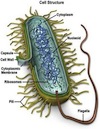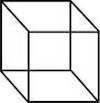Cells and Systems
All Living Things reproduce, grow, and repair themselves, respond to their environment, have a life span, require energy and produce waste.
All Living Things are made up of one or more cells.
Tissue – group of cells similar in shape and function – skin = epithelial tissue
Organs – larger tissue structures – often composed of several different types of tissues. Organs have at least one specialized function. Your heart is an organ made up of different tissues such as epithelial, nerve, fat, and muscle tissue.
Organ Systems – groups of organs that have related functions. The circulatory system includes the heart, arteries, capillaries, and veins. Nerve, blood, epithelial connective and muscle tissue are all found in the circulatory system.
Unicellular organisms (a.k.a. Micro-organisms or Microbes) made of only one cell and must perform all of life’s functions within this cell; such as feeding, digesting, excreting and reproducing.
– some micro-organisms make us sick and others are necessary for us to survive
Bacteria – Prokaryotic cells that differ from plant and animal cells because they do not have a nucleus, mitochondria or ribosomes. Bacteria are micro-organisms that are found in every environment on earth. Some can make their own food while others are parasites.
Protists – Eukaryotic cells that are not considered plant or animals but they do have a nucleus and contain organelles such as mitochondria, ribosomes and lysosomes.
– there are some protists that have plant-like characteristics such as chlorophyll, and they produce their own food by photosynthesis.
– Diatoms are a plant like protist
– Euglena are diatoms that are similar to both plant and animal cells but it depends on the environment they are found in. If there is lots of sunlight they use photosynthesis to make their own food. If they are found in reduced sunlight they will act like animals and feed on smaller cells.
– there are some protists that have animal-like characteristics
– They cannot make their own food and must feed on other living or dead cells
– They have all the organelles of an animal cell
– Amoebae – a protist with animal-like characteristics. It changes shape as it moves by stretching out a branch of cytoplasm called a pseudopod; it also uses the pseudopod for feeding.
– Paramecium – similar to the amoeba, the paramecium uses tiny hairs called cilia, which vibrate and create water currents that help it move. The cilia around the paramecium’s mouth-like structure use the current to draw food inside. Bacteria and smaller cells are its main source of food.
Fungi – can be multi-cellular or unicellular. (mushroom/multi – yeast/uni)
– Yeast is one of the few unicellular fungi. Yeast must rely on other organisms for food and although they might appear to be plant-like they do not contain chlorophyll.
The importance of Cell Division
– eventually every plant or animal cell reaches a size at which it must divide
– cells that do a lot of work are smaller than cells that are not as active (muscle cells vs. fat cells)
Large Cells – take longer to send messages to the cell’s organelles to react to environmental change. The bigger the cell, the longer it takes to send a message to the nucleus and for the rest of the cell to receive instructions.
Small Cells – can react to changes in their environment quicker due to their size. Small cells have a greater surface area to volume ratio; therefore they can take in nutrients and eliminate waste more efficiently because there is more cell membrane compared with the volume of the cell. Since molecules enter and exit through the cell membrane, having more membrane (surface area), compared to volume (space) inside the cell; allows for efficient transport of materials.
Calculating Surface Area, Volume and Ratio of Surface Area to Volume
This cube has six sides. Each side has a surface. The surface has a length and a width that can be measured to determine the surface area. The length and width of each of this cube’s surfaces is 2cm by 2cm. To calculate the surface area of one side of the cube you must multiply 2cm by 2cm, which is 4cm2.
To find the total surface area of the cube, you must multiply your original surface area calculation by 6, because there are six sides to the cube. 4 x 6 is 24 so the total surface area of this cube is 24cm2. We use the power of two, to indicate that we have found the surface area squared, as this includes the two dimensions of length and width being measured.
To find the volume of the cube we consider the three dimensions of the object (length, width and height) and we use the formula, length x width x height to determine the volume of the cube. Since all sides of this cube are equal; the calculation will be 2 x 2 x 2 = 8. The cube has a volume of 8cm3. Or we could say this cube has a volume of 8 cubic centimetres. Here’s another way of looking at it: If you had 8 small 1 x 1 cubes they would fit inside of this cube.
Now, to determine the ratio of surface area to volume, you must consider the total surface area of the cube and the total volume of the cube; and make a comparison using a ratio. The total surface area is 24cm2 and the total volume is 8cm3 so the ratio can be expressed as 24:8 or in simpler terms 3:1. We say there is a 3 to 1 ratio of surface area to volume.
In terms of how this concept relates to the efficiency of smaller cells compared to larger cells, we can look at an example involving a larger cube.
Say we had a 6 x 6 cube. The total surface area would be calculated as 6 x 6 for a single surface area of 36cm2. And then multiply that by 6 to achieve the total for all sides; 36 x 6 = 216. The total surface area is 216cm2. Now we must use the formula for volume (l x w x h); 6 x 6 x 6 . The total volume is the same as the total surface area ; 216. Therefore the ratio is 1:1
An equal surface area to volume ratio allows for less efficient transport of nutrients and waste into and out of the cell.
Having a greater/larger surface area to volume ratio, is more efficient for a cell because the larger cell membrane provides more opportunity or space for the transport of materials into and out of the cell. More opportunity surrounding the cell and less volume to fill the cell, allows the cell to respond quicker to its environment.
A “ratio” is just a comparison between two different things. For instance, someone can look at a group of people, count noses, and refer to the “ratio of men to women” in the group. Suppose there are thirty-five people, fifteen of whom are men. Then the ratio of men to women is 15 to 20.
Notice that, in the expression “the ratio of men to women”, “men” came first. This order is very important, and must be respected: whichever word came first, its number must come first. If the expression had been “the ratio of women to men”, then the numbers would have been “20 to 15”.
Cell Specialization
Unicellular organisms are not considered specialized cells – they have multiple functions
Multicellular organisms benefit from cell specialization. They have different types of cells that perform specialized functions
Plants have specialized cells. The thickness of the cell wall will determine the rigidness of the plant structure.
Flexible plants have thin cell walls (leaves flowers etc)
Rigid plants have thick cell walls (tree bark)
Animals have specialized cells.
Nerve cells are long and thin to promote conductivity of electrical signals.
Lung cells are very thin to allow gasses to exchange rapidly between air and blood.
Red blood cells contain a special protein called hemoglobin. This allows the cell to carry oxygen.
White blood cells contain antibodies. These cells protect the body from invaders by engulfing them and digesting them or killing them with the antibodies.
Cells in the lining of your stomach are protected from stomach acid by a layer of mucus. These cells have many Golgi Apparati, which help produce and store proteins that break down food.
Fat cells are larger and their cytoplasm contains many vacuoles. When the body contains extra nutrients that it does not need; it converts them to fat and it is stored in the vacuoles.
Cells that line the small intestine absorb nutrients through small finger-like projections called villi. The villi provide extra surface area to efficiently absorb nutrients.
Cell Invasion and Protection
Cell invasion is called infection. Some invasions are caused by living things such as bacteria, fungi or parasitic worms.
Other invaders include animal-like protists or viruses.
Dangerous protists are often transmitted thorough water.
Viruses are not living things because they are not true cells. A virus is a small strand of genetic information that is covered by a coating of protein.
Viruses are only active when they invade a living cell. They take over the cell and reproduce more viruses. The cell bursts and a new wave of invading viruses is released.
Our immune system helps the cells protect themselves from these invaders.
White blood cells engulf and destroy the invaders. Their lysosomes release special chemicals to perform this function.
Antibodies are also used to defend the cells. These are made by a special type of white blood cell. Antibodies are large molecules that latch on to the invaders.
Genetic Engineering – the exchange or modification of genetic material in cells.
GE is a newer branch of science research called biotechnology. This industry experiments with cells by changing their characteristics to improve their usefulness to people. There are benefits and disadvantages to this research, which are not fully understood yet.


